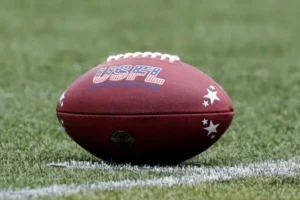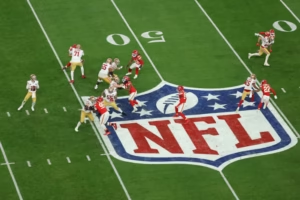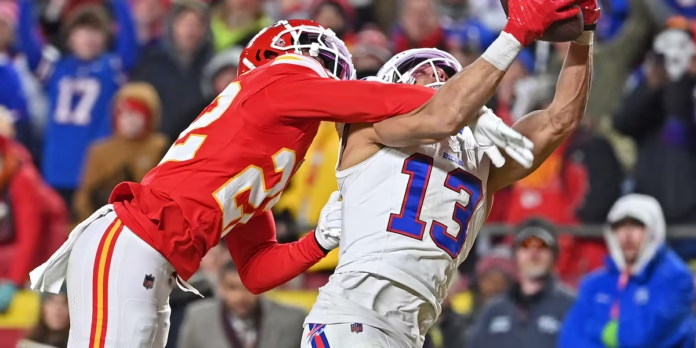The National Football League (NFL) has established itself as a leader in innovation, consistently seeking ways to improve the experience for both players and spectators. Nevertheless, in the realm of one of the sport’s most vital functions ball spotting the league appears to be lagging behind.
Recently, the NFL asserted that technology lacks the necessary precision to replace human officials in this critical task. This claim has ignited considerable debate and prompted inquiries into the league’s dedication to adopting contemporary technological advancements.
This article will examine the NFL‘s rationale, investigate the obstacles to technology integration, and highlight the growing demands from fans and analysts for enhanced practices within the league.
The NFL’s Perspective on Technology and Ball Spotting
In a recent communication with the Associated Press, Kimberly Fields, Esq., the NFL’s Vice President of Football Business Strategy, stated that technology is inadequate for accurately determining forward progress.
Fields noted that while the league is nearing the implementation of technology for first down measurements, the human component remains essential. She remarked, “What this technology cannot do is take the place of the human element in determining where forward progress ends.
There will always be a human official spotting the ball.” This assertion has left many fans and analysts bewildered. Given that the NFL is a multi-billion-dollar entity with access to state-of-the-art technology, why is the league reluctant to fully adopt digital solutions for such a fundamental aspect of the game?

The Difficulties of Technology Integration
Although the NFL’s hesitance may initially appear perplexing, there are important challenges that warrant consideration. For example, assessing forward progress requires subjective interpretation.
Officials must determine when a player’s movement has been halted, a judgment that can differ based on the context. Furthermore, the position of the ball can change during tackles, complicating the ability of technology to accurately identify the precise location in real time.
Nevertheless, contend critics that these obstacles are not beyond resolution. With the evolution of artificial intelligence, computer vision, and sensor technologies, it is feasible to create systems capable of accurately monitoring the ball’s position and correlating it with the moment forward progress ceases.
The pivotal question remains whether the NFL is prepared to allocate the necessary time and resources to realize this potential.
Reasons for Increased Demands from Fans and Analysts
The NFL’s commitment to preserving the existing framework has not gone unnoticed. Both fans and analysts are becoming progressively exasperated with the league’s justifications. Other sports have successfully adopted technology to enhance precision and fairness.
For instance, tennis utilizes Hawk-Eye for tracking ball trajectories, while soccer employs goal-line technology to ascertain whether a ball has fully crossed the line. If these sports can welcome innovation, why is the NFL resistant?
Additionally, the league’s dependence on human officials has resulted in numerous controversies throughout the years. From erroneous calls to inconsistent decisions, these mistakes have frequently overshadowed the game itself.
By declining to investigate technological alternatives, the NFL appears to be favoring tradition over advancement a strategy that could ultimately alienate its fan base.
The Role of Human Officials in the Digital Age
It is important to recognize that the NFL is not entirely resistant to technological advancements. In recent years, the league has embraced innovations such as instant replay and the utilization of tablets for play reviews. However, when it comes to the process of spotting the ball, the league appears to set clear limitations.
Fields’ remarks highlight this issue: “Once the ball is spotted, then the line-to-gain technology actually does the measurement itself. So I think it’s probably been a point of confusion around what the technology can and can’t do.”
While this stance may appear justifiable, it prompts a significant inquiry: If technology is capable of measuring the line to gain, why is it not also utilized to ascertain the ball’s position? By restricting the application of technology, the NFL is inadvertently creating unnecessary obstacles in the officiating process.
The Broader Implications for the NFL
The NFL’s position on technology and ball spotting carries wider implications for the league’s image and future trajectory. In a time when fans increasingly demand transparency and precision, the league’s hesitance to embrace digital solutions may be perceived as a lack of dedication to enhancing the game.
Additionally, this situation underscores a more extensive trend within the NFL: the ongoing conflict between tradition and innovation.
Although the league has made progress in areas such as player safety and fan interaction, its officiating practices remain entrenched in outdated methods. This disconnect could ultimately undermine the NFL’s credibility, particularly as other sports continue to explore the potential of technological advancements.

What the NFL Should Be Doing
The NFL should prioritize the integration of technology into its officiating processes rather than providing justifications for its current practices. To begin with, the league could allocate resources towards research and development aimed at creating systems capable of accurately tracking the ball’s position in real time.
Furthermore, the NFL should consider partnerships with technology firms and academic institutions to devise innovative solutions that address the specific challenges faced in football.
In addition, the league must maintain transparency regarding its initiatives or the lack thereof related to the modernization of officiating. By keeping fans informed, the NFL can showcase its dedication to enhancing the game and responding to public concerns.
The Future of Technology in the NFL
The discussion surrounding technology and ball spotting is expected to persist. As fans and analysts advocate for change, the NFL will encounter mounting pressure to evolve. Although the league’s current position may be disheartening, it is crucial to recognize that meaningful progress requires time.
With appropriate investments and a readiness to adopt innovative practices, the NFL can navigate these challenges and initiate a transformative era in officiating. In the interim, fans can only wish that the league will heed their concerns and take significant actions toward integrating technology into the game.
Ultimately, the NFL’s enduring success has been anchored in its capacity to adapt. By remaining committed to this principle, the league can ensure its continued prominence in the realm of sports entertainment for the foreseeable future.
Expert Editorial Comment
The NFL’s assertion that technology is incapable of accurately locating the ball serves as a clear indication of the league’s hesitance to fully adopt innovative solutions.
Although there are important challenges to consider, the justifications provided by the league are increasingly insufficient for both fans and analysts.
By committing to technological advancements and reevaluating its officiating methods, the NFL has the opportunity to address these issues and improve the integrity of the game.
As the league progresses, it is essential to find a harmonious balance between tradition and advancement. Only by doing so can it truly uphold its status as a pioneer in sports innovation. Until such a time is reached, fans will persist in their rightful demands for greater accountability from the NFL.
